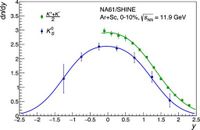In a groundbreaking study, researchers have identified a significant discrepancy in the production ratios of charged versus neutral K mesons, shedding light on the violation of isospin symmetry, a fundamental concept in particle physics.
The study, conducted by the NA61/SHINE collaboration at CERN, reveals that in collisions of argon and scandium nuclei at an energy of 11.9 GeV per nucleon pair, charged K mesons (K+ and K−) were produced at a rate approximately 18.4 ± 6.1% higher than neutral K mesons (K0 and K {overline} K0). This finding contradicts the expectation of equal production rates under the presumption of exact isospin symmetry, which suggests equal numbers of charged and neutral mesons in such nuclear collisions.
The implications of this research are profound. Understanding isospin symmetry is critical not only for theoretical models of nuclear interactions but also for grasping the complex nature of the forces that bind matter together at a fundamental level. This study has unveiled a potential violation of this symmetry that previous models could not account for.
Isospin symmetry is a property derived from the similarity of the up and down quarks, the fundamental building blocks of protons and neutrons. In simpler terms, it implies that these quarks behave similarly under the strong force that holds atomic nuclei together. The observed anomaly in K meson production suggests that there might be unknown factors at play affecting the ratios of these particles produced in high-energy collisions.
Researchers have pointed out that earlier data from various experiments, while consistent with the current findings, did not highlight this disparity strongly enough due to their operational uncertainties. The significance of the detected isospin symmetry violation stands at 4.7σ, a measure that denotes a high degree of confidence in the statistical validity of the results. In essence, this means the findings are unlikely to be due to chance.
The study’s authors emphasize the need for enhanced theoretical frameworks and refined experimental techniques to further investigate this anomaly. They suggest that new systematic high-precision measurements and theoretical models are needed to understand the origins of the observed effects.
Future experiments may include collisions involving other nuclear combinations to probe these effects further. There are plans for the NA61/SHINE collaboration to continue gathering data from various collision systems, including lighter nuclei such as oxygen and magnesium, which could provide additional insights into isospin-breaking phenomena.
As researchers delve deeper into the consequences of this finding, it could influence how physical theories are constructed, potentially leading to a re-evaluation of aspects of particle physics that underpin the nature of strong interactions.
This research not only contributes to existing knowledge but also paves the way for unveiling new physics that challenges current understandings of fundamental interactions. Ultimately, this study may help physicists unlock further secrets of the matter, laying the groundwork for future discoveries.




